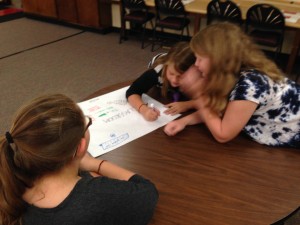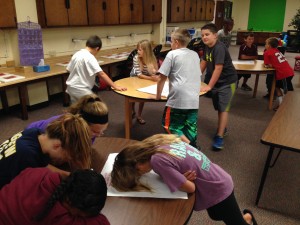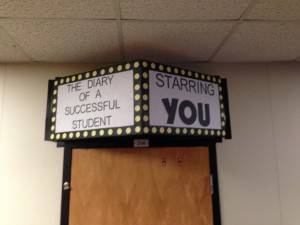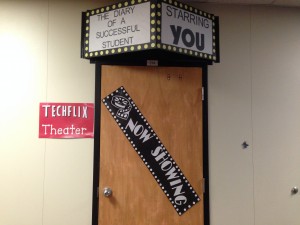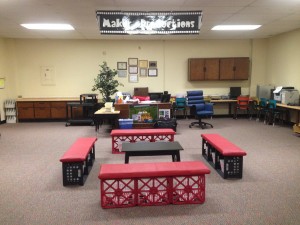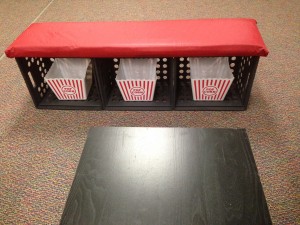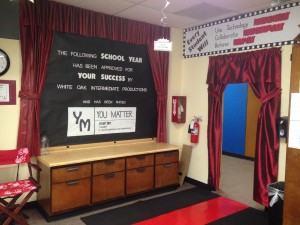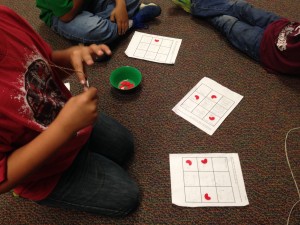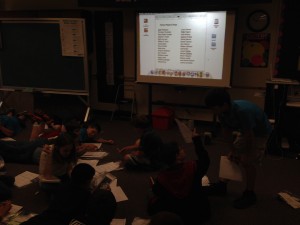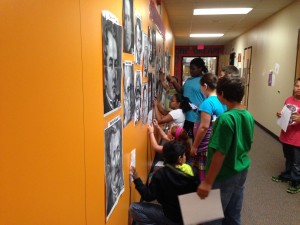My good friend and co-worker, Pam Cranford, sent me an email about MakerBot giving away three 3D printers. The contest winners will be the ones who get the most shares on Facebook, retweets on Twitter, or likes on Instagram. I also came across Buncee today from reading a blog post on FreeTech4Teachers. The third grade teachers at school were looking for a tool for their students to share research on the solar system. I decided to check Buncee out by creating an account and using the tool to post my request for retweets. I wanted to ensure students could embed their buncee creations on their blog, so I embedded my creation here. It looks like Buncee is going to be a great tool for them to use.
Big Idea for November – Service
The Big Idea for November is service. Service means lending a hand to help someone else. According to Character Trades, service is sacrificing my own desires, time, or energy to benefit others. The first step to being of service to someone else is to recognize when someone has a need that you might be able to help.
Kid President encourages us to make a difference. When we serve others, we are truly making a difference!
Students will be creating an origami golden retriever as a reminder to serve others by following the instructions in the video below. While creating their origami, they will discuss in small groups ways they can be of service to someone else. They will write a specific goal of service to someone in the next week on the back.
Big Idea for October – Individuality
Our Big Idea from the Core Essentials curriculum for the month of October is Individuality. Individuality means discovering who you are meant to be so you can make a difference. Students will watch the two videos embedded below:
After seeing the videos, students will be placed in six groups and asked the following questions:
Group 1: What made Nick different from most people?
Group 2: How did Nick initially feel about his individuality?
Group 3: What action(s) did Nick’s feelings about himself lead to?
Group 4: When and how did Nick discover what he was meant to be?
Group 5: What difference did Nick make after the discovery?
Group 6: How can you discover your individuality, and why is it important?
Students will be given a coloring sheet of a zebra without stripes. In their groups, they will place their name on the paper and add the stripes in whatever color and pattern they want. Their sheet will be a reminder to them to begin to discover what they are meant to be so they can make a difference. While they are working at their tables, Will.I.am’s song “What I am” posted below will be playing on the projector screen. When students have completed their zebra, they will capture a picture using Photobooth on the laptop and post it to their blog with the title: “Individuality.”
To read more about Nick’s life, visit his Youtube channel at https://www.youtube.com/user/NickVujicicTV.
Digital Citizenship
This week, third grade students were introduced to Phase 2 (Digital Content) of the Digital Citizenship course. Digital Content refers to the trillions of websites on the internet and the three things students need to understand to be safe: IT’S NOT ALL GOOD, IT’S NOT ALL TRUE, and IT’S NOT ALL FREE. Students explored It’s Not All Good and It’s Not All True. Students were given the following scenario: [You are at home on your computer on a game site. Out of nowhere, an image pops up that makes you feel uncomfortable.] Students voted with their feet to indicate what course of action they should take. Corner 1 – Click on it to try to get it to close or disappear Corner 2 – Ignore it and hope it goes away Corner 3 – Leave the computer and go get an adult. Once in their chosen corner, students had 3 minutes to discuss why they chose their course of action and to choose a spokesperson for their group. When time was up, the spokesperson explained why they chose that course of action.
Students then watched the Garfield video on Fact vs Opinion at https://learninglab.org/life_skills/fact_or_opinion. Students then analyzed the following website to determine if it was factual:
http://zapatopi.net/treeoctopus/.
Fourth and fifth grade students reviewed the three pillars of Digital Citizenship (contact, content, and conduct) by taking the Web License Test 2015-2016 in Moodle.
All About Me
Last week, third grade students learned they have their own place on the web in the form of their blog. Their blog will become their e-portfolio. Students learned to access their blog by typing in its unique url. Students then learned to log in to their blog and create a post called All About Me. Students typed five sentences that described them. Before the activity, students watched this video to understand the things that belong in their Top Secret Folder. Their Top Secret Folder holds all those pieces of information about themselves they should NOT share online without their parents permission. Before publishing their posts, students were instructed to have another student proofread their post and alert them to any sentences that did not begin with a capital letter or end with punctuation.
Fourth and fifth grade students learned how to create a new page on their blog. Students logged in and created a page called All About Me. They included six sentences about themselves, remembering not to post anything that goes in their Top Secret Folder. Students had other classmates proof their post and check for proper sentence structure before publishing. Students watched the following video produced by Mrs. Yollis’ class to learn how to leave comments. Students then left a comment on the All About Me page from two other classmates.
BIG IDEA for September – Initiative
Our campus counselor, who is responsible for teaching Character Education, retired at the end of last year. She used the curriculum provided through Chick-Fil-A called Core Essentials. We would include the information in our daily morning announcements, and she would provide an assembly of sorts once a month to the students. Due to her retirement, I obtained permission from my principal to teach the Big Idea of the month during technology time, so the first week of the month will be focused on the Core Essentials Big Idea of the Month. For the month of September, the Big Idea is Initiative. Students learned that Initiative means seeing what needs to be done, and doing it. Students were introduced to the definition through this video:
Students then formed six groups. Each table had a large sheet of paper and a colored marker with one of these six settings written on it: Home, Classroom, Cafeteria, Playground, Park, and World. Students were given two minutes to collaborate with their group members to decide on one way to show initiative in that setting. After two minutes, they took their marker with them to the next setting to discuss what initiative would look like in that setting.
When all the responses were recorded, we discussed the four kinds of workers in the world: 1) the kind that sees what needs to be done, and does it without being told 2) the kind that asks the boss, what do you want me to do now? 3) the kind that waits until they are told to do a job before doing it, and 4) the kind that the boss cannot ever find to tell them what to do.
Here are the responses from each class:
 |
| Make your own digital slideshow |
A Little More Time on the Clock, Please
The first week of school for the 2015-2016 year is now in the history books. It was an AMAZING, (and to be quite frank, exhausting) week. Students were excited to see the changes to the lab for this year. (See that post here.) They came to understand those changes will only work out if we can meet the three goals we have in the computer lab.
We talked about what it means to use technology RESPONSIBLY, which entails treating the equipment like you worked a summer job and saved your money to buy it, then lent it to a friend. How you want that friend to treat your prized possession is how you should treat the school equipment. We also discussed the other side of the coin, being a responsible digital citizen. That ultimately means, “Think BEFORE you post.” Once you have hit the send button, you have lost control of that post or tweet or message. We talked about what the word “collaborate” means and what it would look like to work together RESPECTFULLY. Then we discussed what Behave RELIABLY means. Students understand I have to be able to trust they are going to leave things the way they found them to be fair to the next group of students coming in the lab.
Students then divided themselves into six groups to work at stations making their own fidgets.
In previous years, I have made fidgets for all my 3rd-5th grade students to keep in their headphone bags. It gives them something to squeeze (provides movement) while they are sitting on the floor to get instructions for the day’s assignment. My plan this year was to provide the supplies and let them figure out the steps to create their fidget. Each table had a QR code that linked to a Youtube video showing the process.
I did not tell students they had to watch the video, but it was available if they chose to. I totally agree that students learn by doing. I totally agree that students need to develop the important skills of collaborating and problem solving. The brick wall we hit this week was LACK OF TIME! Students need TIME to figure things out. As long as our classrooms are driven by schedules, lack of time will be a major roadblock in giving our students all the necessary tools they need to be self-reliant thinkers.
If you do not believe me, just watch this:
What Does it Mean, to Matter?
After watching the video, ask yourself these questions:
What advice was given to Rick’s dad, Dick, concerning the limitations of his son?
If Dick had taken that advice, what would be the reality for Rick and what message would he have received?
What did Rick tell his Dad after the first 5k they ran together?
What do you think Rick experienced in that race that made him feel that way?
Compare yourself to Rick. How are you different? How are you the same?
Compare yourself to his Dad, Rick. How are you the same? How are you different?
The theme of the video was TOGETHER. Dick was the body, Rick was the heart.
So I am asking my students, what does it mean, to matter? What are ways you can consciously, intentionally provide the experience Rick has when he is running with his Dad to others you are blessed to have in your life? What are ways others can relate to you that would send the message to you that YOU MATTER?
Students will get the password to post their response to the padlet wall below.
A Change of Focus
Although this will be my 11th year teaching in this position at this school, this year has a different “feel” to me. There are some major changes I am making in my classroom set-up, and in my own heart and mind. Due to the inspiration I have received from my Twitter PLN, (folks like Angela Maiers, Terri Eichholtz, Joy Kirr, Brian Aspinall, William Chamberlin, Paul Solarz, and Kirsten Wilson, just to name a few), I have decided to let go of traditional tables and chairs in the computer lab and create spaces for student choice. The back of the room is now a designated Maker Production space where students will have 30 minutes of lab time to “play” with an ever growing variety of tools, both digital and physical. They will have choices of where to complete their technology assignments, albeit a ball chair or sitting on the floor with their computer on a low coffee table. Our theme for this year is Hollywood, so I added some theme-related elements to my classroom.
The biggest change has come about in my heart. Our district was fortunate to have Angela Maiers bring our convocation this year with the You Matter Manifesto. She reminded us that being noticed and feeling valuable is not a matter of ideology, but biology. It is a need of every human being, for we were created for significance! Although I believe every staff person in our district understands that, it is also part of the human condition to allow that realization to be overshadowed by the stresses brought about by “covering the material.” My prayer for myself and every other staff member is that we are able to keep that perspective in focus EVERY DAY, for EVERY STUDENT.
4th Grade Famous People Project
My fourth graders ended the year learning about thirty people that contributed to Texas in one way or another. I attempted this project two years ago and became frustrated with the results because of time constraints. This year I built in extra time so students could actually “play” with the information they created. First, I put students in groups randomly by using Classtools.net roulette wheel. I LOVE this tool! I use it often because it is so easy to customize. To group students, I created a wheel with five sections of six colors: red, blue, yellow, green, orange and purple. Students would spin the wheel to get their color, then I would remove that section from the wheel. To determine what famous person that group would research, I created another wheel with the names of the 30 famous people. One person from each group would spin. I would then remove that name from the wheel until all the groups had chosen. Students would then meet in their groups to designate jobs: researcher, script writer, actor/actress, videographer, qr code maker, and poster maker. The researcher would print off the data collection sheet and fill it in. The script writer would take the filled in data collection sheet and write a four to six sentence script in first person. The actor/actress would practice the script and then have someone record just their mouth using an ipod touch. Once recorded, the student would get the completed video uploaded to my Youtube channel. The qr code maker would print out the qr code to the youtube video. The poster maker would make a 2×2 poster of the face of the famous person. The posters were taped to the wall outside the computer lab, and the qr code was taped to the bottom of the poster. Then the real fun began.
Students were handed a 3×3 grid where they chose eight of the famous people from the list projected on the screen. One name was already filled in on their card, so that almost all of the names were covered. Students would take the ipod touch (I have 13 of them) and scan the code for the person pre-written on their bingo card. Once all students had scanned their one code, we played bingo. You can access the document here. I would read off the information of a famous person and then take 3 guesses to who it might be. If they had the person written on their card, they covered that spot with a marker.
All of the information students needed to complete their jobs were placed on a webmix in Symbaloo. The webmix is embedded below along with pictures of students involved in the activity.


